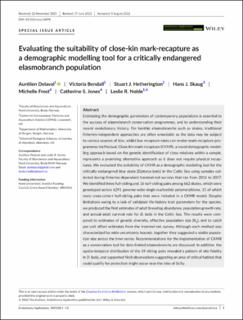| dc.contributor.author | Delaval, Aurelien Nicolas | |
| dc.contributor.author | Bendall, Victoria | |
| dc.contributor.author | Hetherington, Stuart | |
| dc.contributor.author | Skaug, Hans Julius | |
| dc.contributor.author | Frost, Michelle | |
| dc.contributor.author | Jones, Catherine | |
| dc.contributor.author | Noble, Leslie Robert | |
| dc.date.accessioned | 2022-09-27T11:52:07Z | |
| dc.date.available | 2022-09-27T11:52:07Z | |
| dc.date.created | 2022-08-26T10:42:24Z | |
| dc.date.issued | 2022 | |
| dc.identifier.issn | 1752-4571 | |
| dc.identifier.uri | https://hdl.handle.net/11250/3021775 | |
| dc.description.abstract | Estimating the demographic parameters of contemporary populations is essential to the success of elasmobranch conservation programmes, and to understanding their recent evolutionary history. For benthic elasmobranchs such as skates, traditional fisheries-independent approaches are often unsuitable as the data may be subject to various sources of bias, whilst low recapture rates can render mark-recapture programmes ineffectual. Close-kin mark-recapture (CKMR), a novel demographic modelling approach based on the genetic identification of close relatives within a sample, represents a promising alternative approach as it does not require physical recaptures. We evaluated the suitability of CKMR as a demographic modelling tool for the critically endangered blue skate (Dipturus batis) in the Celtic Sea using samples collected during fisheries-dependent trammel-net surveys that ran from 2011 to 2017. We identified three full-sibling and 16 half-sibling pairs among 662 skates, which were genotyped across 6291 genome-wide single nucleotide polymorphisms, 15 of which were cross-cohort half-sibling pairs that were included in a CKMR model. Despite limitations owing to a lack of validated life-history trait parameters for the species, we produced the first estimates of adult breeding abundance, population growth rate, and annual adult survival rate for D. batis in the Celtic Sea. The results were compared to estimates of genetic diversity, effective population size (Ne), and to catch per unit effort estimates from the trammel-net survey. Although each method was characterized by wide uncertainty bounds, together they suggested a stable population size across the time-series. Recommendations for the implementation of CKMR as a conservation tool for data-limited elasmobranchs are discussed. In addition, the spatio-temporal distribution of the 19 sibling pairs revealed a pattern of site fidelity in D. batis, and supported field observations suggesting an area of critical habitat that could qualify for protection might occur near the Isles of Scilly. | en_US |
| dc.language.iso | eng | en_US |
| dc.publisher | Wiley | en_US |
| dc.rights | Navngivelse 4.0 Internasjonal | * |
| dc.rights.uri | http://creativecommons.org/licenses/by/4.0/deed.no | * |
| dc.title | Evaluating the suitability of close-kin mark-recapture as a demographic modelling tool for a critically endangered elasmobranch population | en_US |
| dc.type | Journal article | en_US |
| dc.type | Peer reviewed | en_US |
| dc.description.version | publishedVersion | en_US |
| dc.rights.holder | Copyright 2022 The Author(s) | en_US |
| cristin.ispublished | true | |
| cristin.fulltext | original | |
| cristin.qualitycode | 2 | |
| dc.identifier.doi | 10.1111/eva.13474 | |
| dc.identifier.cristin | 2046248 | |
| dc.source.journal | Evolutionary Applications | en_US |
| dc.identifier.citation | Evolutionary Applications. 2022. | en_US |

